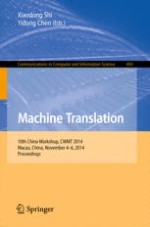2014 | Buch
Machine Translation
10th China Workshop, CWMT 2014, Macau, China, November 4-6, 2014. Proceedings
herausgegeben von: Xiaodong Shi, Yidong Chen
Verlag: Springer Berlin Heidelberg
Buchreihe : Communications in Computer and Information Science
